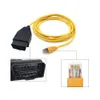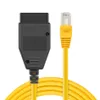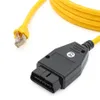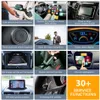Attention all ENET cable consumers! Discover the numerous benefits of using an ENET cable for diagnostics and programming, including faster readings, customized settings, and improved performance. Learn about the various BMW models and systems that are compatible with an ENET cable, both old and new. Plus, get valuable tips on how to choose the right ENET cable for your specific needs, such as selecting the appropriate length and connector type. Don’t miss out on maximizing your diagnostic and programming capabilities with the right ENET cable.








Benefits of using an ENET cable
One of the primary advantages of using an ENET cable is the faster and more accurate readings that it provides. With its high data transfer rate, an ENET cable can quickly transmit data between the vehicle and diagnostic tools, allowing for real-time analysis of any issues. Additionally, because ENET cables are designed specifically for automotive applications, they are well-suited to handle the unique requirements of complex systems.
Another benefit of using an ENET cable is the ability to customize settings to meet specific needs. Whether it’s adjusting parameters for engine performance or tweaking transmission settings, ENET cables allow for easy and precise adjustments to be made. This level of customization not only leads to improved performance but also helps technicians troubleshoot problems more effectively.
Improved performance is another advantage of using an ENET cable. By providing faster and more accurate readings, ENET cables help identify potential issues before they become significant problems. This means that vehicles can be serviced proactively, reducing downtime and ensuring that they perform optimally at all times. Additionally, because ENET cables allow for real-time monitoring of critical systems, technicians can detect changes in performance and address them before they become catastrophic.
Finally, ENET cables offer a range of benefits beyond just diagnostics and programming. For example, they can be used for firmware updates and software upgrades, ensuring that vehicles always have access to the latest features and capabilities. They also provide a convenient way to connect multiple devices, simplifying the process of integrating various components into a single system.
Compatible systems and models
One of the most popular BMW models that is compatible with an ENET cable is the 3 Series. This includes the F30, F31, F34, and F80 models. The ENET cable can be used to access the vehicle’s onboard diagnostics and coding capabilities, allowing for customization and troubleshooting. Additionally, the 5 Series (F10, F11, F07) and 7 Series (F01, F02, F03, F04) also support the use of an ENET cable, making it easier for consumers to manage their vehicle’s software and performance.
Moving on to the SUV lineup, the X5 (F15, F85) and X6 (F16, F86) are also compatible with an ENET cable. These vehicles offer a range of advanced features that can be accessed and modified using the ENET cable, providing a more personalized driving experience for consumers. Furthermore, the M Series models such as the M3, M4, and M5 are known for their high-performance capabilities, and the use of an ENET cable further enhances the ability to fine-tune and optimize these vehicles.
For those who own older BMW models, it is worth noting that vehicles from the E Series, such as the E60, E70, E71, and E89, are also compatible with an ENET cable. This opens up opportunities for owners of these vehicles to take advantage of the latest diagnostic and coding technologies, ensuring that their cars remain up to date and optimized for performance.
In addition to the specific models mentioned above, the ENET cable is designed to work with a wide range of BMW systems. This includes the iDrive system, which controls the vehicle’s infotainment and navigation functions, as well as the engine management system, transmission control unit, and various other modules within the vehicle. With the use of an ENET cable, consumers can gain access to these systems and make adjustments or modifications as needed.
Choosing the right ENET cable
Firstly, it’s important to consider the length of the cable. A longer cable may be needed for larger rooms or to reach distant locations from the modem. However, keep in mind that the longer the cable, the more signal loss there will be. This can result in slower internet speeds, so it’s best to choose the shortest cable possible that will still meet your needs.
Secondly, the connector type is also an important factor to consider. There are two main types of connectors: the RJ45 and the RJ11. The RJ45 connector is typically used for Ethernet connections, while the RJ11 connector is used for telephone connections. It’s important to choose the correct connector type for your specific needs.
Next, consider the category of the cable. The category determines the speed and performance of the cable. Category 5 cables were the standard for many years, but now Category 6 and Category 7 cables are available and offer faster speeds and better performance. If you are using a high-speed internet connection, it’s recommended to choose a higher category cable for optimal performance.
Another consideration when choosing an ENET cable is the shielding. Shielded cables have an additional layer of protection that reduces interference and signal loss. They are more expensive than unshielded cables, but if you live in an area with a lot of electronic interference, such as near power lines or other electronics, a shielded cable may be worth the investment.
Lastly, it’s important to consider the overall quality of the cable. Cheaper cables may seem like a good deal, but they often have lower quality materials that can lead to signal loss and slower speeds. Higher quality cables may cost more, but they offer better performance and durability.
In conclusion, choosing the right ENET cable is important for getting the best internet experience. Consider the length, connector type, category, shielding, and overall quality when making your decision. With these tips in mind, you can select a cable that meets your specific needs and provides optimal performance.
FAQ
Q: What is an ENET Cable and how does it help with BMW maintenance?
A: An ENET (Ethernet to OBD) Cable is a specialized cable that connects your BMW vehicle’s OBD port to your computer or laptop. It enables you to diagnose, code, and program various systems in your car, including engine management, airbags, ABS, and more. With an ENET Cable, you can perform advanced diagnostic scans, read and clear fault codes, activate hidden features, and even customize your car’s settings.
Q: Can I use any ENET Cable for my BMW vehicle?
A: No, not all ENET Cables are created equal. To ensure maximum compatibility and reliability, it’s important to choose a high-quality ENET Cable that’s specifically designed for BMW vehicles. Cheap or generic cables may not work properly or could cause damage to your car’s sensitive systems. Look for a premium ENET Cable that’s made from quality materials, has a sturdy connector, and supports the latest protocols.
Q: Do I need any special software or tools to use an ENET Cable?
A: Yes, you will need some basic tools and software to use an ENET Cable effectively. First, you’ll need a computer or laptop with a USB port and a compatible operating system (Windows or MacOS). You’ll also need a diagnostic and programming software that’s compatible with your BMW model. Popular options include BMW ISTA-D, ISTA-P, INPA, NCS Expert, and E-SYS. These software programs allow you to access and control various systems in your car using the ENET Cable.
Q: Is it easy to use an ENET Cable for BMW maintenance?
A: With the right software and basic knowledge of car mechanics and coding, using an ENET Cable for BMW maintenance can be relatively easy. However, it’s important to follow proper instructions and safety precautions to avoid damaging your car or causing any malfunctions. If you’re new to BMW coding and diagnostics, it may be helpful to seek advice or guidance from experienced users or professional mechanics. There are also many online resources and tutorials available to help you get started.